How to glue plexiglass: types and brands of the best products
If you do not have reliable information about the type of polymer, we will select plexiglass glue with the expectation that it really is PMMA. In principle, if you have already dealt with gluing plastic, then there will be no intrigue in the question of how to glue plexiglass for you: the guarantee of the strength of the seam is still in solvents.
A small educational program for those who have not previously dealt with gluing plastics: the most reliable option for gluing polymers is to dissolve the edges to be glued to a viscous state with the help of solvents and dock them until they dry. So the product is essentially monolithic, and the seam holds even when the product begins to crack and break in other places.
How to glue plexiglass so that you are pleased with the result? There are several options here.
Factory glue
Of course, the most convenient formulations for working with plexiglass are various types of factory glue. Indeed, why look for something to glue plexiglass, and invent something when everything has already been invented for us?
- Artifix is a reactive adhesive, which is currently considered the highest quality and most convenient when working with plexiglass. The seam obtained with its help is strong, transparent and durable, and the toxicity is lower than the toxicity of solvents if there is no dichloroethane in the composition (there are variations without its addition). True, it is better to use this glue for plexiglass if you have a small production: it is not very profitable to lay out about 6-8 thousand rubles per liter package to glue the model. The most commonly used numbers are 116, 117, 106 and 190, depending on the degree of viscosity you want.
- Colacril is a slightly more budgetary replacement for the previous glue, but judging by the reviews, Artifix cannot be outdone. The most commonly used numbers are 20 and 30. Different numbers can be mixed to obtain the desired viscosity.
- Cosmofen for acrylic glass is a cyanoacrylate-based superglue, also called liquid plastic. That is, a monolithic connection will be obtained only if the acrylic of the glue matches the acrylic from which the plexiglass is produced. Most often it is used when working with plastic windows: there it fits perfectly. In other cases, you will still get a pretty strong and durable seam, and for not the most money. Please note that Cosmofen may require UV curing!
Solvents
You can make your own glue with a completely identical polymer, and this can be done using solvents. Yes, it will set a little slower, but the result will not be worse!
- How to make the perfect glue at home? Dissolve some of your plexiglass shavings in dichloroethane! Yes, the substance is quite toxic and it is better to work with it in the fresh air, but the parts will stick to each other just tightly!
- If EDC is not found, you can look for tetrohydrofuran. Depending on the nuances of the composition, it glues some types of plexiglass even better than the famous dichloroethane.
- In desperate situations, you can glue the pieces together with formic acid, glacial acetic acid, or even ordinary vinegar essence. Not with table vinegar, but with concentrate.
In general, you can glue the parts without diluting the chips - if you apply a solvent to both parts, connect them and fix them until dry, the seam will again turn out to be monolithic.
Contact adhesive
What about the other options? There are a lot of other types of glue, which, no, no, yes, they will advise on some resource. Unfortunately, you shouldn't count on a really high-quality seam and gluing "for centuries" with them, and that's why.
- Sometimes epoxy resin is recommended for gluing plexiglass, because it really holds the joint well, and even completely transparent. But it just connects the two parts of the plexiglass, without turning them into a monolith.
- Adhesives like "Super Moment" do not change the structure of the material and create a very fragile seam: they can only be used for gluing together the elements of the product, which is practically unloaded. In addition, when using them, the plexiglass becomes cloudy and the seam becomes very noticeable.
- The usual "Moment" and similar compositions will not last long either: they can only glue what you are not going to actively use, and that will hold up mediocre.
Planned repair and maintenance of the greenhouse
Scheduled work is carried out annually, at the beginning and end of the summer cottage season. The list of works can be different and depends on the condition of the greenhouse. Sometimes in the process of scheduled repairs, hidden defects are discovered, in which case they are also eliminated.
Greenhouse cleaning
Preventive maintenance traditionally starts with wet cleaning
Washing is important not only for disinfection and cleaning of the greenhouse - after removing the dirt, defects in the coating of the frame may appear, requiring repair. In addition, cracks and cloudiness are better visible on washed polycarbonate, it is easier to assess the degree of its transparency.
The greenhouse is washed internally and externally with a medium-pressure hose, and in the presence of heavy dirt, using a soft sponge or non-woven cloth and non-aggressive detergents. Thoroughly rinse the polycarbonate itself, the joints between it and the frame and the attachment points of the elements. After washing, open the doors in the greenhouse and dry it well.
Note! It is better to wash the greenhouse in calm weather - in a strong wind, dust will quickly settle on a damp surface
Inspection of the foundation, frame and coating
The inspection is started after the greenhouse is completely dry in good daylight and pay attention to:
- haze and yellowing of polycarbonate;
- cracks, punctures, dents in the coating;
- polycarbonate fastening strength;
- water and dirt in internal cavities;
- pockets of peeling paint on the frame;
- traces of corrosion on metal parts;
- pockets of mold and mildew on the tree;
- softening areas of wood;
- the overall stability of the greenhouse;
- cracks in the foundation.
All these damages require repair and sometimes replacement of structural elements of the greenhouse. The urgency of the implementation depends on the type of malfunction and the time of detection. So, the centers of corrosion or decay of the frame can be left until spring - in frosts, these processes are rather slow. It is also better to replace polycarbonate in case of cloudiness in spring.
Cracks in the foundation and violation of the stability of the greenhouse must be eliminated before the onset of frost and snowfall. Water trapped in cracks will freeze and expand, leading to their enlargement and possible destruction of the base. With general instability or softening of the frame wood under the weight of the snow, the greenhouse may collapse.
Self-tapping screws
Even properly fixed self-tapping screws weaken over time, and the mobility of polycarbonate increases. This can lead to deformation during strong winds. They stretch the self-tapping screws with a screwdriver, simultaneously removing the dirt and dust that has got under them.
The degree of tightening should be such that the polycarbonate holds firmly in place, but does not sag under the washer. If the self-tapping screw turns and does not hold well, it is changed to fasteners with a greater length or diameter.
Protective coating renewal
Polycarbonate greenhouses can be either metal or wooden frame. These materials must be covered with a protective coating - in conditions of high humidity, the metal rusts, and the tree rots.
For metal, nitro enamels are used over the primer layer, for wood - paint or antiseptic. Over time, the coating layer can be broken, especially often at the points of abutment and attachment of elements. There is another weak point on the metal frame - the welded seams. On them, corrosion is possible even under a layer of paint.
Coating restoration sequence
Step 1.Polycarbonate at the place of work is temporarily removed or insulated with film, cardboard, gluing them to tape. Clean areas with a poor condition of the coating with a spatula, emery paper or a sander to the ground.
Step 2. The metal is treated with an anticorrosive compound, the wood is treated with an antiseptic. Dry the frame for the time indicated on the packaging of the product.
Step 3. A layer of protective coating is applied, similar to what the greenhouse frame is painted with. For metal, weather-resistant enamels are used, including hammer enamels. For wood - outdoor enamel or latex-based impregnation.
Table 1. Protective coatings for metal and wood.
Methods for fixing polycarbonate
Polycarbonate can be connected with each other or with other materials by riveting, melting, gluing. Most often, metal and polycarbonate rivets are used for the connection. Before riveting, the ends to be joined are preheated. When gluing polycarbonates, special solvents are used: methylene chloride or ethylene chloride.
It is recommended to lay polycarbonate with point fastening. For this, thermal washers and self-tapping screws are used. Thermal washers are considered more reliable. They provide a more airtight fastening of polycarbonate profiles. Thanks to the foot of the thermal washer, deformation of the polycarbonate sheets can be avoided. The step for point attachment should be at least 3-4 cm. It must be remembered that the panels must not be rigidly fastened and the screws must not be overtightened.
When corner joint of cellular polycarbonate, you can use corner polycarbonate profiles. They hold the profile sheets very securely and the corner joints are practically invisible. The polycarbonate wall profile is used when joining the panels to the wall. The ridge profile is very reliable for connection, it is made taking into account the thermal expansion of the panels. Its "wings" have a fairly powerful grip of 4 cm.
Before laying polycarbonate, boards or planks must be installed for support. When working with polycarbonate panels, do not use sharp objects and cutting tools.
How to patch a hole in a greenhouse?
Most often, holes and cracks appear on the surface of plastic after winter. This is the result of the temperature drop and the abundance of precipitation. The answer to the question: "How to glue the cellular polycarbonate in this case?", You can only after assessing the damage.
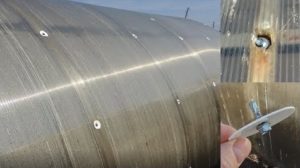
In order to eliminate small cracks on structures made of monolithic material, you can use:
- scotch tape. Not the preferred option. It will not last long, and after removing it, dirty spots will remain on the surface. However, if you need to solve the problem quickly and as a temporary improvised means, such material is quite suitable;
- insulating tape. This option is also short-lived and is only suitable for an emergency. But unlike scotch tape, it can be called more professional;
- sealant. Transparent silicone sealants do the job well. They do not allow water and wind to pass through, and at the same time are almost invisible on the surface. Not recommended for long-term use, as in the open air and under the influence of the sun, the sealant quickly becomes thinner and dirty;
- adhesive film. Thin and durable material that can be purchased at any hardware store;
- liquid nails. With their help, you can handle small cracks and sheet joints.
To glue the polycarbonate of the honeycomb variety, you can use a homemade solvent-based glue. For this you need:
- finely chop the carbonate and mix with a solvent;
- stir until a homogeneous consistency is obtained;
- at this time, stick adhesive tape from the outside on the damaged surface;
- draw the resulting liquid into a syringe and gently apply the substance from the inside to the crack or fill the hole;
- wait a few minutes until it hardens completely and remove the tape.
An example of working with homemade glue can be viewed here:
Visually filling cracks and small holes is presented in this video:
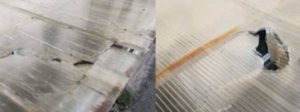
If the hole is more than 7-10 cm, the defect can be repaired with a patch. Most often, pieces of plastic of the same type as the base of the greenhouse are used for these purposes. Before installing the patch, the surface must be sanded and degreased, since it is more logical to glue polycarbonate to polycarbonate using the adhesive bases described above. The easiest way to repair a greenhouse is to put a patch on silicone glue:
- cut out a piece of plastic of the required size with a margin of 3-4 cm on each side;
- treat the surface with alcohol and clean for more intense contact;
- apply a transparent sealant around the perimeter of the hole and glue the prepared piece tightly to the base;
- then screw in the screws at the corners of the patch. The length and size of the screw is not important;
- after the sealant has completely solidified (the time is indicated on the package), treat all joints with sealant;
- unscrew the screws and fill the remaining holes with sealant;
- sealed joints are checked every year and, if necessary, the protection is renewed.
In case of more serious damage or the formation of gaps larger than 20 cm, it is advisable to completely replace the panel or tape. This will make the structure more reliable and sealed.
Glue at home
To glue firmly, durable and unobtrusively, you should:
- Thoroughly degrease the bonding area with a rag soaked in gasoline or alcohol. Even the smallest finger marks can compromise the strength of the seam.
- Fix the parts so that there is a small gap between them.
- Apply glue to both parts. An injection syringe is excellent for this purpose. It allows you to carefully dose the applied mass. The syringe needle should be finalized with a file or an abrasive bar, removing the bevel. If you leave a bevel, splashing is possible. With a syringe, the adhesive mass is introduced into the gap between the parts.
- Press the parts tightly against each other and fix so until the connection engages. Thick plexiglass can be clamped in a vice or clamps. More fragile parts are tied to each other with an elastic bandage.
- Withstand from a minute to half an hour, depending on the volume of the applied adhesive.
To protect surfaces that cannot be glued from the ingress of glue, you can pre-glue them with masking tape (paper tape).
How to properly glue polycarbonate
Let's consider the process of gluing polycarbonate sheets together using the example of using COSMOFEN PMMA glue.
All work is carried out in several sequential stages:
-
Surface preparation.
Before starting work, the bonding surfaces should be cleaned from grease, dirt, dust, moisture and other contaminants. We recommend cleaning with lint-free wipes and the special cleaner COSMOFEN 20. Isopropyl alcohol is also suitable for cleaning and degreasing. - Glue application
... It is recommended to apply COSMOFEN PMMA with a snake to one of the glued surfaces directly from the tube. -
Bonding sheets
... Immediately after application, the cellular polycarbonate should be glued to each other (maximum open exposure time - 60 seconds). The elements to be glued can be additionally secured with a load if necessary. The glue line can be exposed to stress after 16 hours.
A common question is how to repair cracks and punctures in cellular polycarbonate?
To do this, you can use a transparent silicone sealant.
At the same time, before starting work, water and dust are removed (blown out by a compressor) from the polycarbonate cavities, the edges are processed so that there are no scuffs and burrs, after which they carefully inject silicone sealant into each hole using an assembly gun.
For small damages, you can also use a special sealing tape.
VIDEO INSTRUCTIONHow to remove excess adhesive from polycarbonate?
Removal of acrylic or polyurethane adhesive from the polycarbonate surface can be carried out by rolling the adhesive film immediately after detecting smudges.
A polycarbonate greenhouse, like any other structure, requires regular maintenance and sometimes repair. This article will tell you about the proper care of the greenhouse, as well as the techniques and methods of repair.
In order to maximize the service life of a polycarbonate greenhouse, it is necessary not only to eliminate the malfunctions and damages that have arisen, but also to prevent their occurrence. With proper greenhouse maintenance, most of the troubles can be avoided.
Preventive maintenance of the greenhouse includes:
- the washing up;
- visual inspection;
- pulling screws;
- renewal of the protective coating of the frame;
- checking the strength of the structure;
- strengthening the greenhouse for the winter.
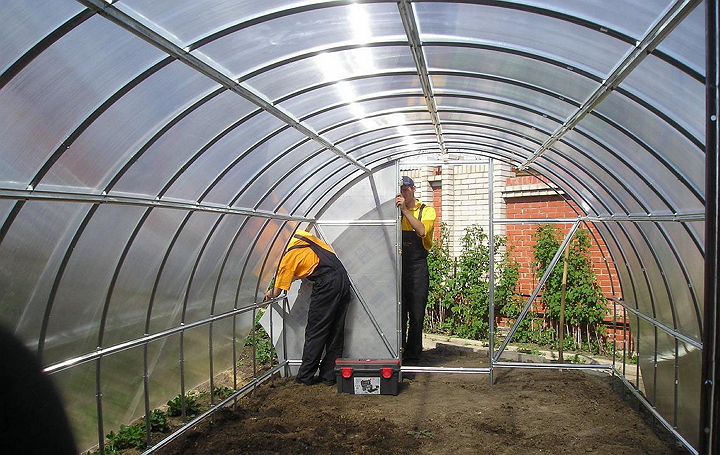
When a malfunction occurs, repair work is carried out:
- full or partial replacement of polycarbonate;
- sealing cracks and punctures;
- blowing out internal cavities from water and dust;
- frame repair;
- repair of the foundation.
All work must be carried out in a timely manner - so damage will be minimal, and you will avoid unnecessary costs. The best time for routine maintenance of the greenhouse is spring or autumn, when the outside temperature is stable above zero, but there are no plants in the greenhouse. It is better to start repair work immediately, since most breakdowns entail further destruction of the greenhouse.
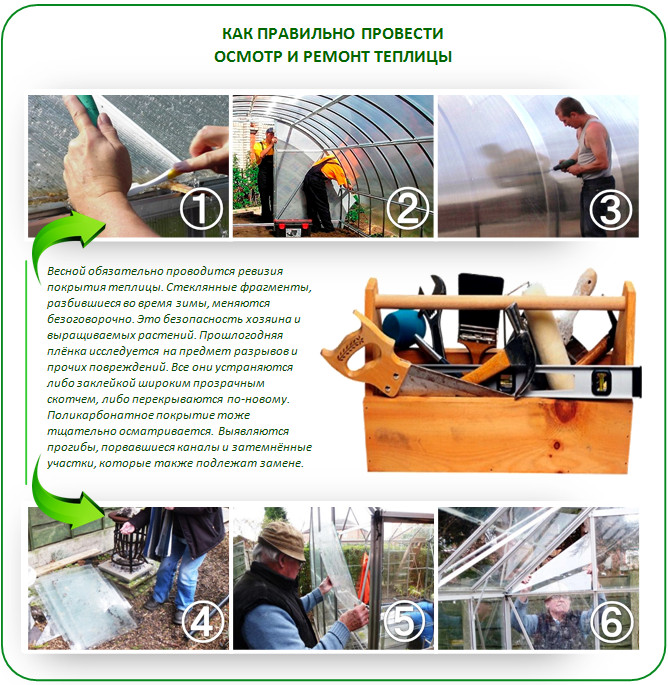
Polycarbonate sheet mounting technology

It is most convenient to attach the sheets to the already finished structure frame on one-piece profiles. At the same time, panels of the required size are first cut out, then profiles are attached to the frame with self-tapping screws with thermal washers. Polycarbonate panels are inserted into the grooves of the profiles. In order to increase the strength of the fastening, the grooves are additionally coated with silicone sealant. At the same time, the upper edges of the panels are hermetically closed with an aluminum tape, and the lower ones - with a perforated one, then special end profiles are put on them. This is necessary to protect the polycarbonate honeycomb from moisture and dust.
Fastening with split profiles is carried out with nails to a wooden plank or frame. If the profile is attached directly to the frame, then the fastening is carried out with self-tapping screws with thermal washers in increments of 30-50 cm. Pre-cut polycarbonate panels are placed in the base of the profile, and a split profile cover is put on top, which is gently tapped with a wooden mallet or rubber hammer. As in the case of one-piece profiles, the grooves are coated with a sealant.
Polycarbonate is often used in the construction of sheds, greenhouses, canopies and other structures. For large-scale projects, all kinds of fasteners are used, but in small buildings it is easier to do with gluing. In this article, you will learn how to choose a glue for polycarbonate.
Construction of unloaded lightweight structures ↑
Gluing of parts of light structures - interior decoration elements, stands for displaying goods in shopping centers, which are not subject to special requirements during operation, is usually carried out with one-component glue. For this, either thermo guns with special sticks made of adhesive are used, or ready-made compositions with various bases.
For quick connection of sheets of monolithic polycarbonate, it is convenient to use a heat gun with glue sticks. The process is reduced to melting the rods and dosed application of hot liquid glue. This glue reliably adheres monolithic polycarbonate to metal, rubber, glass and other materials.
Pistols have a wide price range - the most affordable are Chinese models, devices from famous brands are much more expensive and are of high quality. So, for example, the gun BOSCH GKP 200 CE has two heating elements, electronic temperature stabilization, high productivity.Professional modern models are equipped with an adhesive spray, which allows you to quickly and economically glue large surfaces of materials.
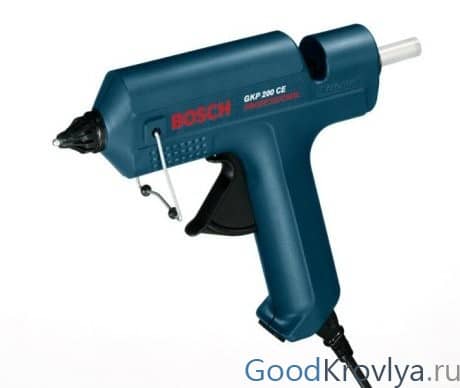
Consumable material for the operation of the thermal gun - special rods purchased for a specific model. For household pistols, rods with a diameter of 7 and 11 mm are made; for industrial purposes, thicker rods are used - up to 43 mm. The set with the gun sells short rods, 5 cm long, you can separately purchase rods designed for longer use - 20 cm or more.
The most commonly used rods are made of ethylene vinyl acetate, designated as EVA, the material is translucent, elastic, non-hygroscopic. Manufacturers produce rods painted in various colors and unpainted ones - matte and translucent. All compounds adhere well to almost any materials during their preliminary cleaning and degreasing; good results are also obtained for cast polycarbonate.
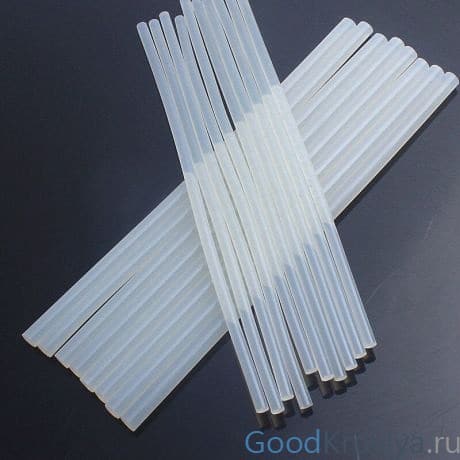
The best reliability of the seam is given by polyamide, its designation PA, such an adhesive for monolithic polycarbonate is characterized by greater rigidity, strength and melting point than ethylene vinyl acetate.
Polyamide is used only in pistols that have a "hot mode" - its melting temperature is 150 ° C, almost twice as high as that of ethylene vinyl acetate. The disadvantage of polyamide is the gradual decrease in strength in high humidity conditions.
Small structures can be glued without special tools with glue that does not require heating before use. Modern one-component compounds are able to ensure the strength of the seams to various influences, while maintaining the elegant appearance of the product. The most popular and high-quality products, according to experts, are the products of the German companies Weiss (COSMO series) and RöhmGmbH (ACRIFIX series).
Cosmofen products are popular thanks to their traditional German quality. A wide range of models allows you to choose an adhesive for monolithic polycarbonate with the desired parameters - white or transparent composition, instant and long-term curing, with different viscosities. All types of products have common properties:
- provide high reliability of the seam;
- withstand a wide temperature range;
- do not allow moisture to pass through;
- retain their quality under the influence of ultraviolet radiation.

A very popular one-component composition based on methyl methacrylate ACRIFIX 192, which does not contain a solvent. This glue does not contain dichloroethane and provides high performance characteristics. Glue ACRIFIX 116,117,118 also does not contain dichloroethane, but is made on the basis of a solvent. The adhesion strength of such a composition is less than that of a polymerizing one; its use can have negative consequences for the properties of polycarbonate.
If it is necessary to join flat polycarbonate surfaces with other materials, it is recommended to use double-sided adhesive tape. Sample Type 4830 from 3M gives excellent adhesion thanks to the acrylic foam adhesive. Thorough cleaning of materials and degreasing of surfaces before gluing the tape is necessary.
The question of how to glue polycarbonate with polycarbonate is not worth it separately for small products made of monolithic plastic - you can use one-component glue. The best result when working with a hot-air gun is given by glue based on polyamide; the reputation of world-renowned manufacturers serves as a guarantee of reliable bonding and flawless bonding with cold-curing compounds.

What is the glue for plexiglass
Plexiglass glue is chosen depending on the wishes of the consumer himself.
new one-component Wiko Plexy adhesive for plexiglass (plexiglass)
There are two types of glue used to repair, restore the integrity of products:
An adhesive mixture of acrylic with a solvent, used for extrusive (cast) acrylic (it is also plexiglass, plexiglass). Professional glue.During the connection of two identical components under the influence of the third active substance, a strong connection of the bases occurs due to the dissolution of the surface molecular layer of plexiglass. The gluing is monolithic. There are some nuances. Although this group is intended directly for bonding plexiglass (plexiglass), not all adhesives in this group will be able to bond all types of these materials.
This is very important, there are exceptions, so you need to be careful when choosing a composition for certain brands of PLEXIGLAS, which is the general name of the trademark.
Two-component adhesive based on epoxy resin or cyanoacrylate. With their help, you can quickly glue individual parts
Suitable in some cases, and can be used for a small area of work.
Household adhesives for joining plexiglass are divided into two groups according to the principle of action:
- The former include active substances that are applied to the joints before gluing. The surfaces are melted. The master glues them while the material is liquid. After drying, a monolithic seam is formed.
- Compositions forming a connecting layer between the individual parts. A less durable seam is formed than during the melting of the surfaces to be joined.
In order not to be mistaken during the selection, it is necessary to consider the most popular products for gluing plexiglass.
new two-component adhesive Wiko Dual Glue for plexiglass (plexiglass)
Acrifix 116 glue
Acrilfix plexiglass adhesive, which produces high-quality substances that are used when joining various materials. Product 116 is a transparent formulation, a thick mixture (more viscous than Acrifix 117), which is similar in consistency to a flowing resin. Packaged in 100 ml tubes.
Used for gluing rough parts with uneven edges. Effectively fills in the voids caused by chips, creates a homogeneous surface. One component adhesive. It hardens by evaporation and absorption of solvents by the parts to be joined.
Acrifix 117
If a person does not know how to glue plexiglass, any experienced craftsman will call him Acrilfix 117 glue. This mixture is considered the best for gluing acrylic-based materials. He has a number of strengths and weaknesses.
Advantages:
- High strength of the finished seam.
- Dries quickly.
- The lowest level of toxicity compared to analogues.
- Long shelf life.
- Penetrates small cracks, fills them to the ground.
- The transparent seam is practically invisible on the total area of the glued surface.
Disadvantages:
- Very high price.
- Rarely comes across on the shelves of hardware stores.
- It is impossible to buy a small capacity. The standard package size is 1 liter.
Experienced craftsmen recommend mixing Acrilfix 117 with 116 (10/1) in order to reduce the consumption of expensive glue. In addition to this, the mixture better fills the voids of microcracks. The quality of the seams does not deteriorate.
Colacril 20 glue
When gluing plexiglass, craftsmen often use Colacril products. It costs less than Acrilfix, however, its properties are close to expensive mixtures. Item 20 is a flowable adhesive that can be used to make transparent, strong, durable seams. Similar in its actions to the previous brand, but cheaper.
Colacril 30
It differs from the name 20 - in consistency. It is thicker, so that 30 is mixed with 20 to get the desired thickness of the adhesive. The lack of adhesives from this company is that they crack at the bend. This violates the integrity of the connection, degrades the appearance.
BRAUBERG glue
This transparent adhesive is universal for a large number of different materials, differing in their structure. Sold in a package called a show box. Glues and joins wood, metal, PVC of any hardness, polystyrene, porcelain, ceramics, plexiglass, glass. Also glues rubber, felt and leather.
Advantages:
- Versatility.
- Water resistance.
- Elasticity of the sealed seam.
- Bonds porous materials.
- Glues plexiglass and plain glass.
- A symbolic price.
